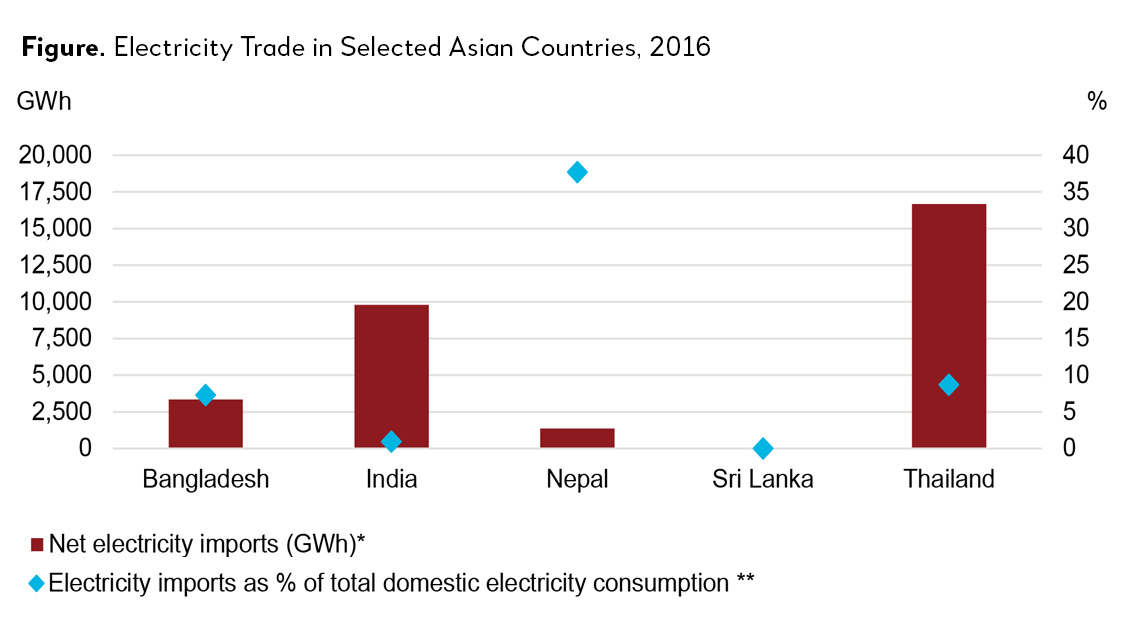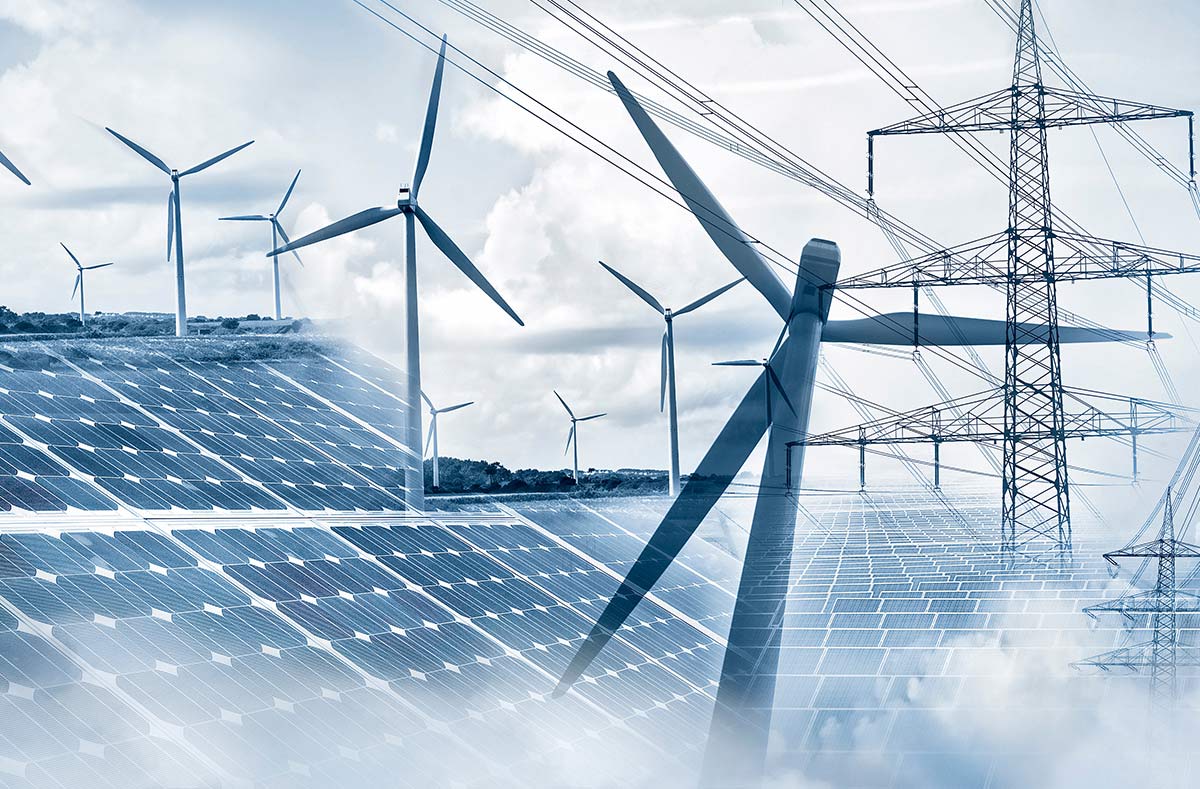This article builds on Chapter 4.3 of Asian Infrastructure Finance 2019: Bridging Borders: Infrastructure to Connect Asia and Beyond (2019, AIIB and EIU), which discussed the green imperative and developing interconnected low-carbon power networks in Asia.
How far should countries go in the deployment of large-scale renewables such as hydropower, solar and wind? Should they fully exploit their renewable energy economic potential? Or instead, should they invest in energy efficiency, distributed generation and energy storage to reduce the need to build more gigawatts of renewable power plants? Whatever the choice, the role of cross-border power transmission for renewables—or a Green Super Grid—will be imperative to the transition to a low-carbon future in a growing Asia.
There are increasing examples of developing countries with fast growing energy demand that are reaching their limits for large-scale renewables, such as Bangladesh and Sri Lanka. The challenges they are facing include high population density, displacement of indigenous peoples, land scarcity, limited transmission capacity, conflicting use of land for agriculture and fisheries, proximity to rich and unique biodiverse areas, poor financial situation of national power companies, border or maritime disputes, low renewable energy potential and poor financial viability of investments, limited carrying capacity of rivers with multiple hydropower dams and areas with a swarm of large wind turbines, among many others. Of course, these are some of the same issues faced by large fossil fuel power plants.
Yet there are countries with vast and economically viable renewable energy resources and ample land that could sell their cheap renewable power to neighboring countries which are struggling to reach their climate targets under the Paris Agreement and ensuring access to “affordable, reliable, sustainable and modern energy for all” under the United Nations Sustainable Development Goals. For example, India can play a key role in delivering low-cost solar and wind power to Sri Lanka and Bangladesh, as well as enabling Nepal to export low-cost run-of-the-river hydropower to Bangladesh and Myanmar through India. Similarly, the Middle East could be a major source of cheap solar power to the region.
Advantages of a Green Super Grid for Asia
- Building on bilateral and multilateral power trade. Compared with Europe’s long-established electricity market, where member states trade on average 11 percent of their electricity, power structures within Asia are a disjointed affair (Figure).1 The vast distances and differences in terrain, infrastructure and demand mean that overall trade in electricity consumed is estimated at less than 1 percent, while some big users, like Japan and the Republic of Korea, are not connected to any neighboring grids.2 India and Sri Lanka also do not have any power interconnection despite only about 20 kilometers of ocean between them.
- Where links exist, they mainly involve bilateral agreements to export excess capacity, especially climate-dependent hydropower, on to neighbors. Bhutan, which has a 100 percent electrification rate, is the most active exporter, channeling about 70 percent of the electricity it produces via run-of-the-river hydropower onward to India (India, in turn, helped finance three major dams that generate most of Bhutan’s power). Lao PDR, thanks to its favorable position on the Mekong River, has been exporting traditional hydropower to Thailand since the 1970s; it recently expanded its links such that around 60 percent of its electricity now flows beyond its borders.3

Sources:
*South Asia Regional Initiative for Energy Integration. Dec. 2017. BIMSTEC Energy Outlook 2030.
** EIU calculations based on the BIMSTEC Energy Outlook 2030 and International Energy Agency, Statistics, accessed Nov. 23, 2018.
- Achieving efficiency of scale. In economic terms, connections over larger geographies mean countries can take advantage of different time zones to sell power to their neighbors while their own people sleep, which makes sense for intermittent renewables like wind, which can blow day or night. Distance matters in Asia, where some of the richest resources are in far-flung, less populated areas. Mongolia, with just three million people, has a wind power potential twice the current global installed capacity. China suffers from supply bottlenecks in its own windy north, India is struggling to expand its grid infrastructure in line with a recent explosion in solar farms in the west and south.4 In July 2020, Australia’s government announced their plan to dispatch their immense renewable energy resources, combined with battery storage, from its Northern Territory to Southeast Asia through a USD15.8 billion investment.
- Promoting broader regional cooperation. Regional grid initiatives could potentially pave the way for economic ties in other areas, too, and create interdependencies that can add to regional cohesion. In Central Asia, when construction recently started on a project to connect Tajikistan and the Kyrgyzstan—which have surplus hydropower—to Afghanistan and Pakistan, Afghanistan’s president hailed it as an opportunity to bring “peace and stability” to the region.5
But a Green Super Grid for Asia will not happen overnight. Europe’s grid has been connected for over half a century and still only a tenth of the available power is traded among member states; Asia’s most developed interconnection projects in South Asia and Southeast Asia have each been in the planning stage for around two decades and are only now taking their first steps toward multilateral trade.6 Among the issues to iron out are licensing agreements, harmonizing technical standards and guidelines on transmission pricing.7 With the price of energy storage falling quickly, countries will also need to weigh the costs and benefits of large-scale, complex transmissions projects against localized and distributed forms of energy that can be deployed more rapidly such as in Myanmar.
Asia has a huge untapped potential for renewables, and regional networks could help develop more capacity, boost access and support stronger economic integration. Whatever the eventual time frame, what is clear is that further connections within Asia are likely,8 making regional power grids one more of the many options to reach our global climate and sustainable development goals.
See other articles on energy and infrastructure by the same author:
- Revitalizing Aging Infrastructure—The Growing Need for Hydropower Modernization in Asia by David Morgado.
- The Line Where the Sky Meets the Sea is Calling for Offshore Wind by David Morgado.
- Historic Low Oil Prices—Not an Immediate Threat to Renewables, But World Must Not Lose Green Momentum by Aalok Pandey and David Morgado.
Related reads:
1 Asian Infrastructure Investment Bank and the Economist Intelligence Unit. 2019. Asian Infrastructure Finance 2019: Bridging Borders: Infrastructure to Connect Asia and Beyond. p. 99, citing the Renewable Energy Institute. 2017. Asian Super Grid Interim Report 2017.
2 Ibid.
3 AIIB and EIU. Asian Infrastructure Finance 2019. p. 99, with citations.
4 Ibid.
5 Ibid, citing CASA-1000. 2017. “Casa 100 enters construction phase with signing of EPC contracts for over 500 km of high voltage direct current transmission line in Afghanistan”.
6 Ibid., p. 102.
7 Ibid., p. 100.
8 Ibid., p. 102.


